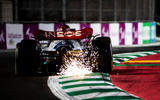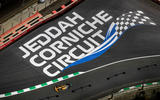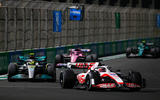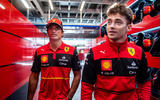The Formula 1 2022 rules revolution has started encouragingly. Both the Bahrain and Saudi Arabian Grands Prix produced dramatic fights for victory between Red Bull’s Max Verstappen and Ferrari’s Charles Leclerc. These rank among the most dramatic back-and-forth battles for victory of 21st century F1.
The competitive order has been shaken up, with last year’s worst two teams, Haas and Alfa Romeo, now strong top 10 runners and long-time dominant force Mercedes-AMG no longer a victory threat. The financial playing field has also been made more even thanks to the cost cap that limits how much teams spend on designing, developing, building and running cars to a baseline figure of $140 million (£107m) per year. The cars also look good, replacing the Frankenstein’s Monster mish-mash that cars had become with cleaner aerodynamics and more pleasing proportions.
But correlation does not equal causation. The objective of the new technical regulations, which reintroduced powerful ground-effect venturi tunnels outlawed for 1983, was to improve what F1 MD and tech boss Ross Brawn calls the ‘raceability’ of the cars. So have these changes really worked?

The consensus among drivers and teams is that significant progress has been made in the number one objective of the rules. This was to reduce the turbulent airflow wake created by a car. ‘Dirty air’ compromises the aero of a following car, costing it downforce and causing it sliding around. The consequence is less grip and overheating tyres, which is not conducive to launching an overtaking move.
The changes are the result of the most comprehensive research programme conducted by F1 in association with the FIA. The simplified aerodynamics with the fussy flicks, vanes and elaborate shapes outlawed have resulted in what McLaren technical director James Key describes as “massive brute-force [aero] surfaces, a huge front wing, a massive floor which is very powerful and far less complexity above that”.
Firstly, that airflow disturbance is mitigated (but not eliminated as the laws of physics dictate the only way you can avoid that would be to run in a vacuum). Secondly, the shape of the wake has been changed to send more of the turbulent air over, rather than directly towards, a following car. Thirdly, those brute-force aero surfaces and venturi tunnels work better in the turbulence that remains.
Brawn describes these rules as “not just the one-stop solution”. The research continues under the auspices of the FIA using the vast amounts of car data generated and the regulations will continue to be evolve in the coming years to “add raceability”. This will be on top of what is already a promising start.
“The really encouraging thing about these regulations is that in the last two races we've seen Charles and Max pass each other about 10 times, which we haven't seen in previous seasons,” said Red Bull team principal Christian Horner. "It's been great racing. From a sample of two, you'd have to say it's a big tick in the box for the ability to follow closely and race wheel to wheel. It's been outstanding.”

But the ability to follow more closely does have a downside and the slipstream is anecdotally less powerful. The drag-reducing hole punched in the air is not as big as it was previously for the same reason that the turbulence is reduced. It explains why it still requires a big pace advantage for one car to overtake another.
“Following was definitely easier. We spotted that in testing,” said Fernando Alonso after the Bahrain Grand Prix. “Overtaking is still not as easy as it seems on TV. All the overtakes we saw today were because one car had two seconds more pace and newer tyres than the others. The tyre is the biggest differentiating factor still, not the following.”
F1 changed from 13in to 18in wheel rims this year and Pirelli was tasked with making its new low-profile tyres less prone to overheating and allow drivers to push harder with reduced management.
Driver feedback was positive during testing, but the races have shown the old limitations have perhaps not been improved by as much as hoped.
“Here, it felt very similar to last year on this track,” said Alfa Romeo driver Valtteri Bottas of the tyres after the Saudi Arabian GP. “In Bahrain, it felt very similar.
“When you’re closer, when you’re pushing, you overheat them and you lose time. I’m not feeling big improvements. In the first two races, the feeling was that they weren’t that much better than last year’s. There’s always room to improve and let’s see in a couple of races.”

More data is needed before definitive conclusions can be drawn on the tyres. Bahrain is a heavily rear-limited track with plenty of low-speed traction zones that, in hot conditions, takes a lot out of the tyres. The Jeddah circuit in Saudi Arabia is a bizarre, unrelenting high-speed challenge that is also atypical. The next two races at more conventional Melbourne and Imola will give us a clearer picture.
In defence of the tyres, the minimum weight in 2022 is 798kg. That represents a 34% increase since 2008. Pirelli can do more, but it cannot change the laws of physics and that weight means a huge amount of energy going through the rubber.
The rules also aimed to close the competitive spread. There are still clear groups – Red Bull and Ferrari up front, Mercedes in no-man’s land behind, then a midfield headed by a rotating cast of Haas, Alfa Romeo and Alpine with AlphaTauri also in the mix and struggling McLaren hanging onto the back of that group. At the back are Aston Martin and Williams, but even they are within 2.5% of the pace – the smallest gap in F1 since 2009.
This is down to the simplified cars, both in terms of aero and mechanically with suspension systems simplified thanks to the ban on inerters and hydraulic assistance, and the cost cap. But there’s another factor, which is the aerodynamic testing restrictions controlling wind-tunnel runs and CFD items that give the teams ranked lower in the constructors’ championship more of that testing than those above them.

Everything we have seen from F1 in 2022 suggests that the new rules are at least a qualified success. But the two dramatic races we’ve seen so far this year can’t purely be attributed directly to those changes. They were also the consequence of two evenly matched teams with great drivers and a little help from the DRS that is still necessary to deliver raceability.
F1 still has more work to do, but what we can say definitely is that this is the biggest step F1 has taken to combat the trend for wheel-to-wheel racing being harder to produce in the aero era.
But whether what we’ve seen so far is a step, a stride or a giant leap in the right direction remains to be seen.
Edd Straw



















Join the debate
Add your comment
The racing has also been better because the revised overtaking rules stop Max pushing drivers off first chance he gets, so the battles go on longer and are more entertaining. Massi needed to grow some cojones last year and nip the problem in the bud, but he repeatedly failed.
First two races between Max and Charles have been epic!
The real Litmus test would be Monaco, no lengthy periods of full throttle, will passing be safer there?, it's a show race anyway, a Track where Verstappen is likely to crash out of?, Pitstops are more critical.
Exciting, last 3 races all involve the safety car and pit lane timinig being the key to winning. Lets see if the excitment is there after a couple of races without a SC
But yes the new regulations are allowing the cars to follow closer but most overtakes still needed the DRS affect.